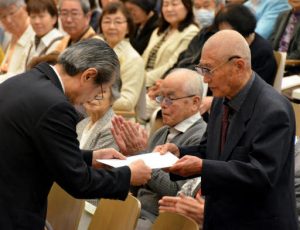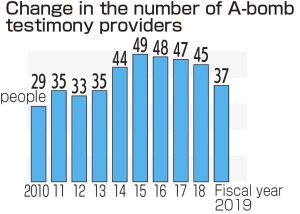Sharp drop in number of A-bomb survivors sharing their experiences
Apr. 10, 2019
(by Junji Akechi, Staff Writer)
Efforts to train more “memory keepers”
In the current fiscal year, the number of A-bomb survivors sharing their atomic bomb experiences at the Hiroshima Peace Memorial Museum, located in Naka Ward, has fallen to 37, eight less than in the previous fiscal year. In recent years, the number of such survivors has been gradually decreasing by one or two every year due to aging, but the decline this time is significant as a result of retirements and deaths. The Hiroshima Peace and Cultural Foundation, an organization located in Naka Ward which has entrusted the A-bomb survivors with the task of conveying their A-bomb experiences, now must recruit more A-bomb survivors who will share their A-bomb experiences, while they also need to enhance their efforts to train more “memory keepers” to inherit and hand down the survivors’ testimonies.
On April 9, a commissioning ceremony was held at the Peace Memorial Museum. This fiscal year, 37 A-bomb survivors aged from 76 to 93 living in and outside the city of Hiroshima, including one newcomer, will provide testimony of their A-bomb experiences. In the previous fiscal year, there were 45 registered survivors. However, three people passed way, including Hiromi Hasai, a nuclear physicist who died in January, and six others decided to retire due to ill health and at the request of their families who were worried about their physical condition.
The testimony providers will share their experiences with visitors to the museum and with students at schools to which they are dispatched. In the last fiscal year, they conveyed their A-bomb experiences 1,742 times to a total of 135,000 people. This program of survivors sharing their accounts first began in 1983. Originally, the testimony providers were introduced by A-bomb survivors’ organizations. In fiscal 2012, however, a two-year training system was established and survivors could then nominate themselves for the role of testimony provider. As a result, since fiscal 2014, the number of providers has fluctuated between 44 and 49.
The museum’s Outreach Division said, “We hope that A-bomb survivors will continue sharing their accounts, but out of a concern over their advanced ages, we can’t force the issue.” As they get older, the two-year training has become a burden to the elderly survivors, which means that recruiting new testimony providers has not been easy.
On the other hand, the number of memory keepers has grown to a total of 131, including 15 newcomers who have completed the three-year training program. In fiscal 2018, they made presentations to approximately 85,000 people, and the museum’s Outreach Division plans to continue strengthening its training program for memory keepers and its efforts to secure opportunities where they can pass on the survivors’ experiences.
Mizusu Nakamoto, 63, a housewife and resident of Higashi Ward who was registered as a memory keeper on April 9, will take over the presentation of the testimony of Fujio Torikoshi, a resident of Fuchu-cho who died last June. Mr. Torikoshi experienced the atomic bombing while in the Yamate-cho (now part of Nishi Ward), approximately 2 kilometers from the hypocenter. Ms. Nakamoto expressed her resolve by saying, “During the training, Mr. Torikoshi told us that we would be conveying his A-bomb experience on behalf of all the A-bomb survivors. So I have to continue passing on the thoughts and feelings of Mr. Torikoshi, who did all he could, as if shortening his life, to convey his experience to others.”
(Originally published on April 10, 2019)
Efforts to train more “memory keepers”
In the current fiscal year, the number of A-bomb survivors sharing their atomic bomb experiences at the Hiroshima Peace Memorial Museum, located in Naka Ward, has fallen to 37, eight less than in the previous fiscal year. In recent years, the number of such survivors has been gradually decreasing by one or two every year due to aging, but the decline this time is significant as a result of retirements and deaths. The Hiroshima Peace and Cultural Foundation, an organization located in Naka Ward which has entrusted the A-bomb survivors with the task of conveying their A-bomb experiences, now must recruit more A-bomb survivors who will share their A-bomb experiences, while they also need to enhance their efforts to train more “memory keepers” to inherit and hand down the survivors’ testimonies.
On April 9, a commissioning ceremony was held at the Peace Memorial Museum. This fiscal year, 37 A-bomb survivors aged from 76 to 93 living in and outside the city of Hiroshima, including one newcomer, will provide testimony of their A-bomb experiences. In the previous fiscal year, there were 45 registered survivors. However, three people passed way, including Hiromi Hasai, a nuclear physicist who died in January, and six others decided to retire due to ill health and at the request of their families who were worried about their physical condition.
The testimony providers will share their experiences with visitors to the museum and with students at schools to which they are dispatched. In the last fiscal year, they conveyed their A-bomb experiences 1,742 times to a total of 135,000 people. This program of survivors sharing their accounts first began in 1983. Originally, the testimony providers were introduced by A-bomb survivors’ organizations. In fiscal 2012, however, a two-year training system was established and survivors could then nominate themselves for the role of testimony provider. As a result, since fiscal 2014, the number of providers has fluctuated between 44 and 49.
The museum’s Outreach Division said, “We hope that A-bomb survivors will continue sharing their accounts, but out of a concern over their advanced ages, we can’t force the issue.” As they get older, the two-year training has become a burden to the elderly survivors, which means that recruiting new testimony providers has not been easy.
On the other hand, the number of memory keepers has grown to a total of 131, including 15 newcomers who have completed the three-year training program. In fiscal 2018, they made presentations to approximately 85,000 people, and the museum’s Outreach Division plans to continue strengthening its training program for memory keepers and its efforts to secure opportunities where they can pass on the survivors’ experiences.
Mizusu Nakamoto, 63, a housewife and resident of Higashi Ward who was registered as a memory keeper on April 9, will take over the presentation of the testimony of Fujio Torikoshi, a resident of Fuchu-cho who died last June. Mr. Torikoshi experienced the atomic bombing while in the Yamate-cho (now part of Nishi Ward), approximately 2 kilometers from the hypocenter. Ms. Nakamoto expressed her resolve by saying, “During the training, Mr. Torikoshi told us that we would be conveying his A-bomb experience on behalf of all the A-bomb survivors. So I have to continue passing on the thoughts and feelings of Mr. Torikoshi, who did all he could, as if shortening his life, to convey his experience to others.”
(Originally published on April 10, 2019)









